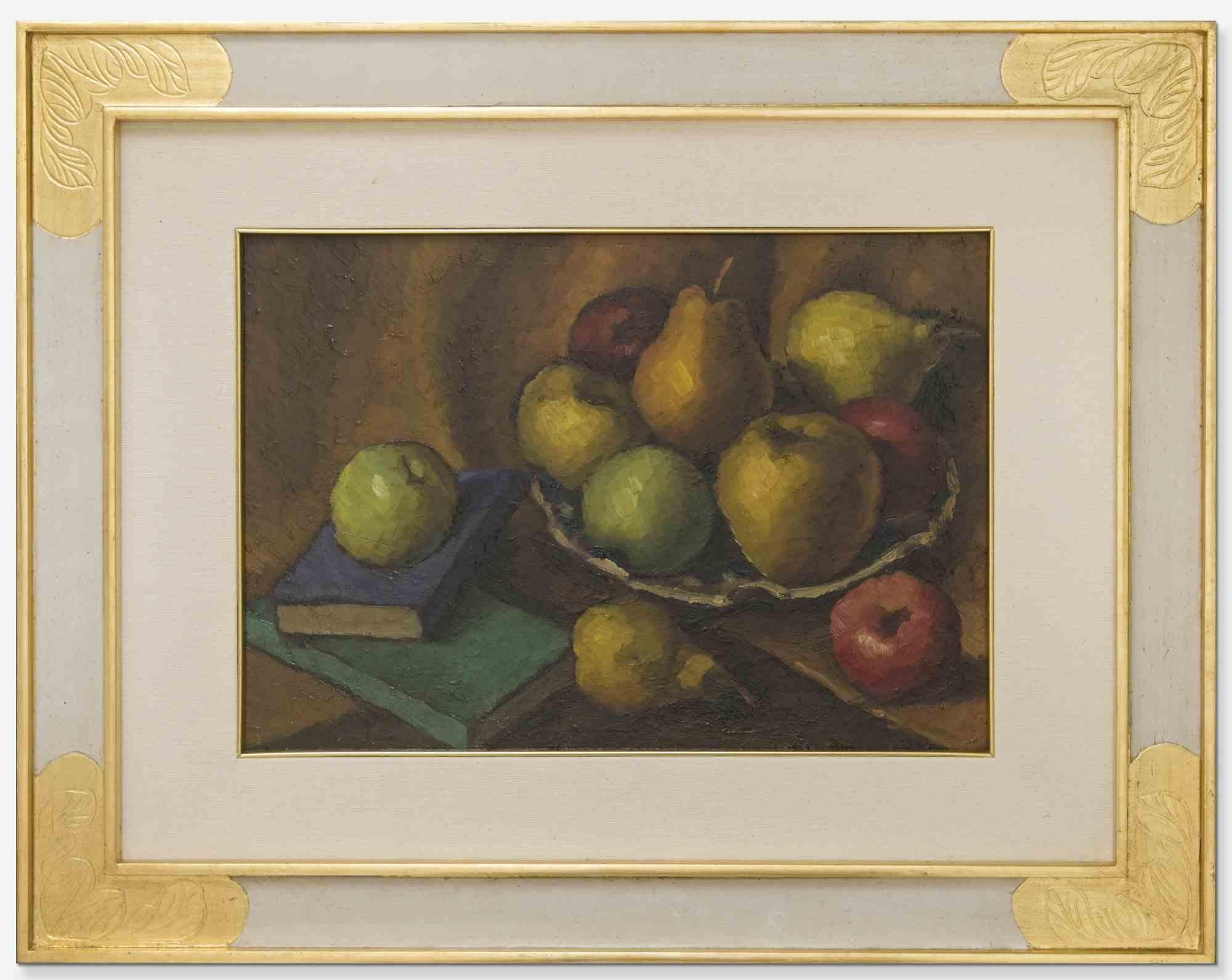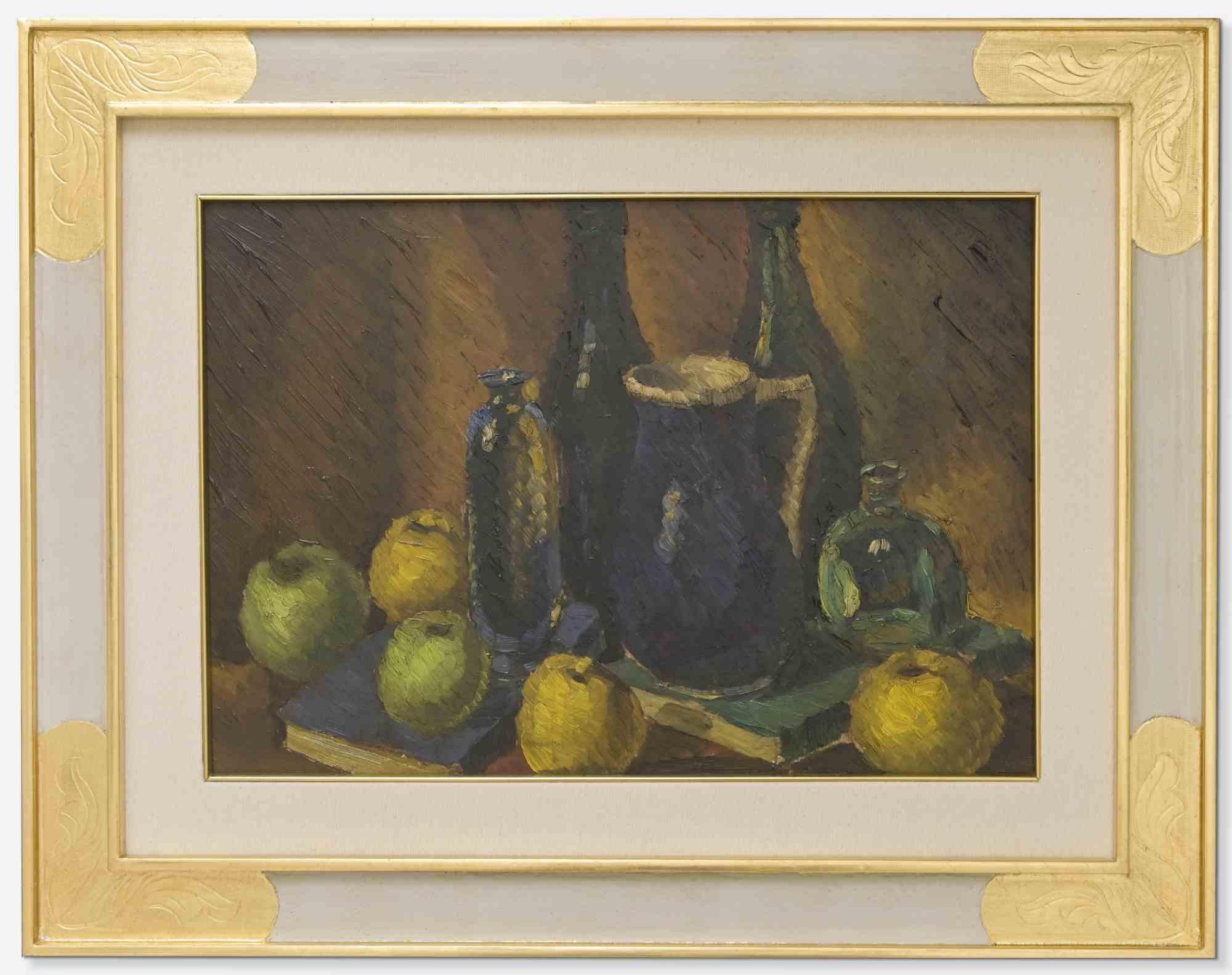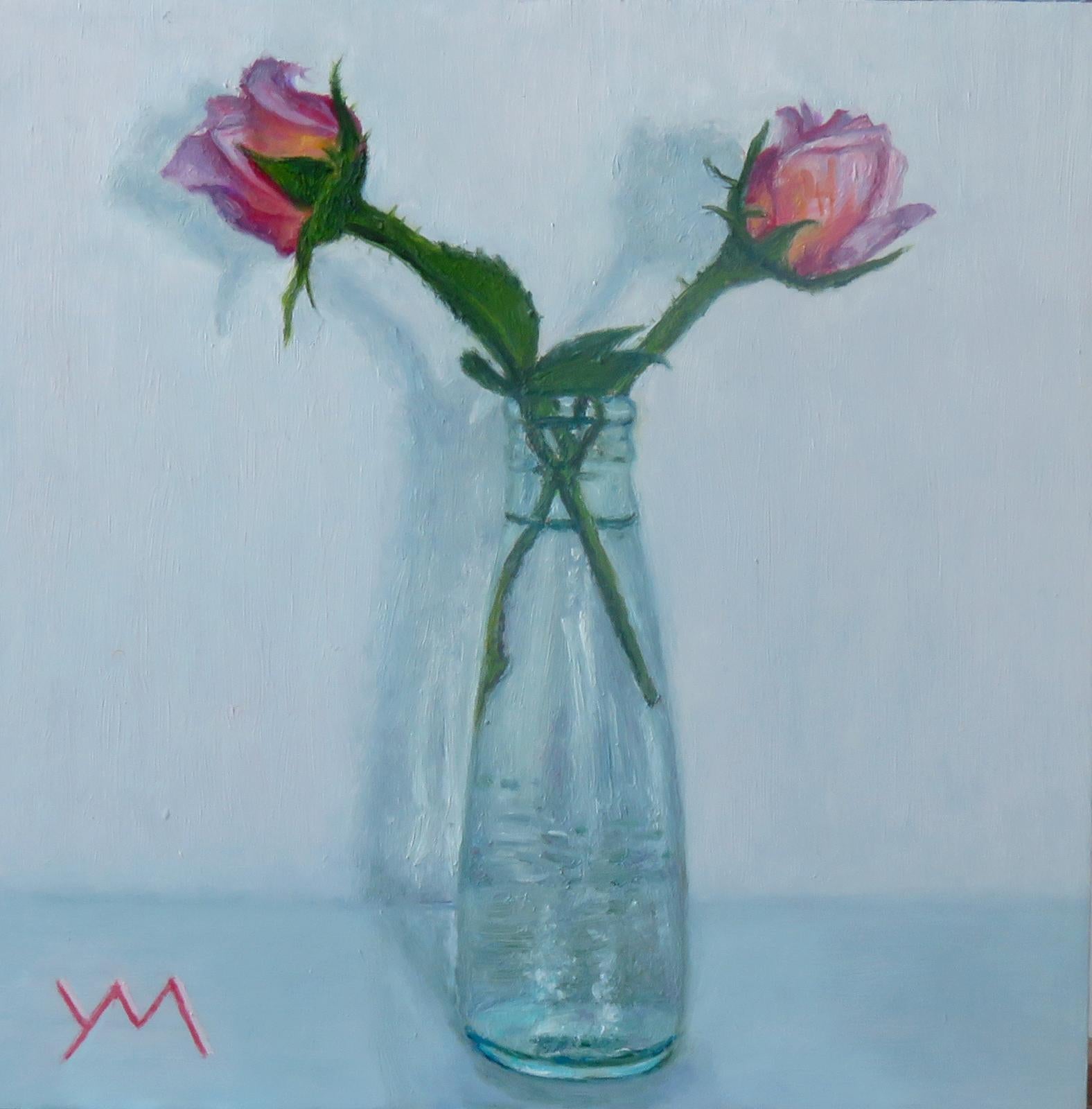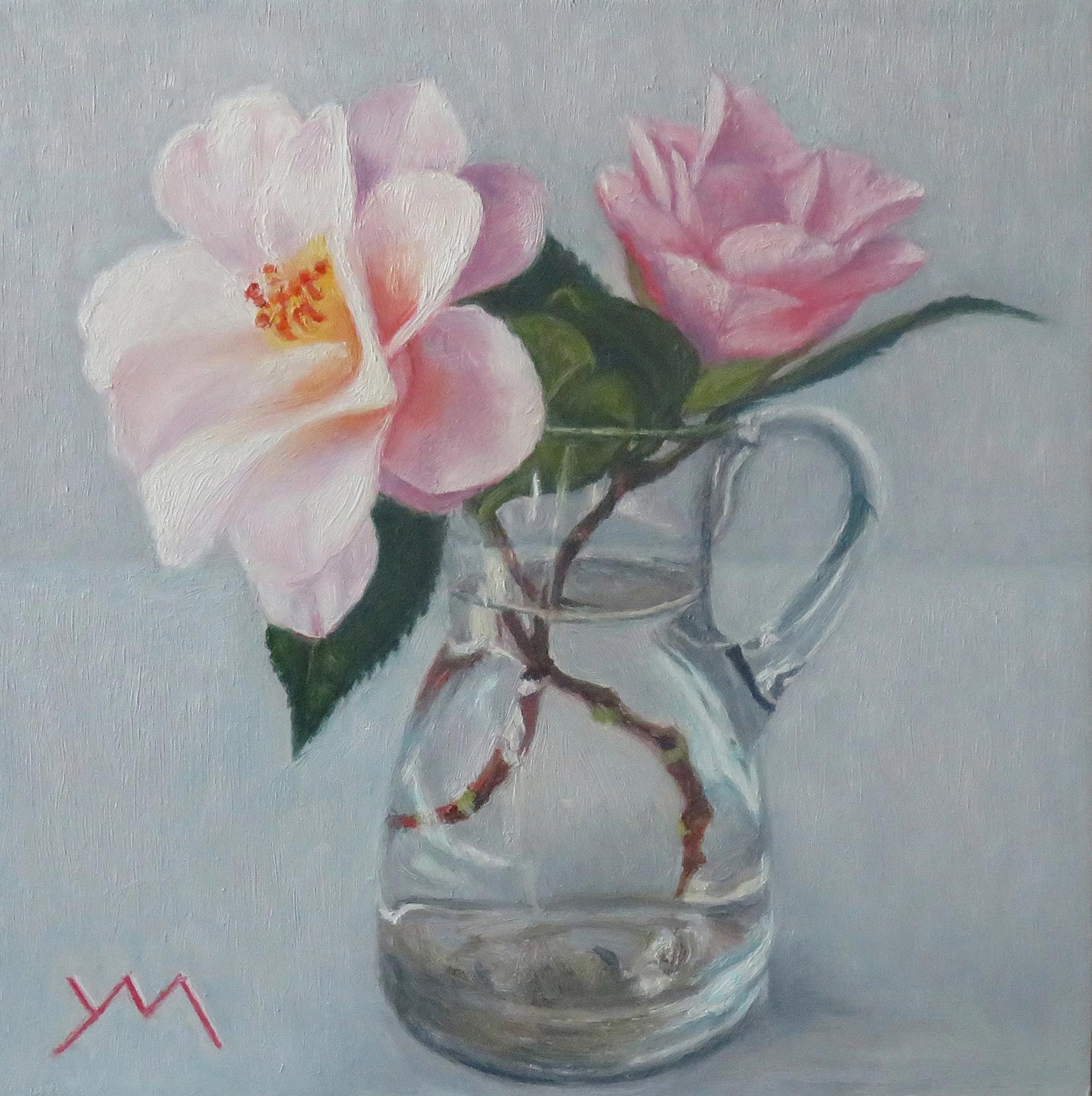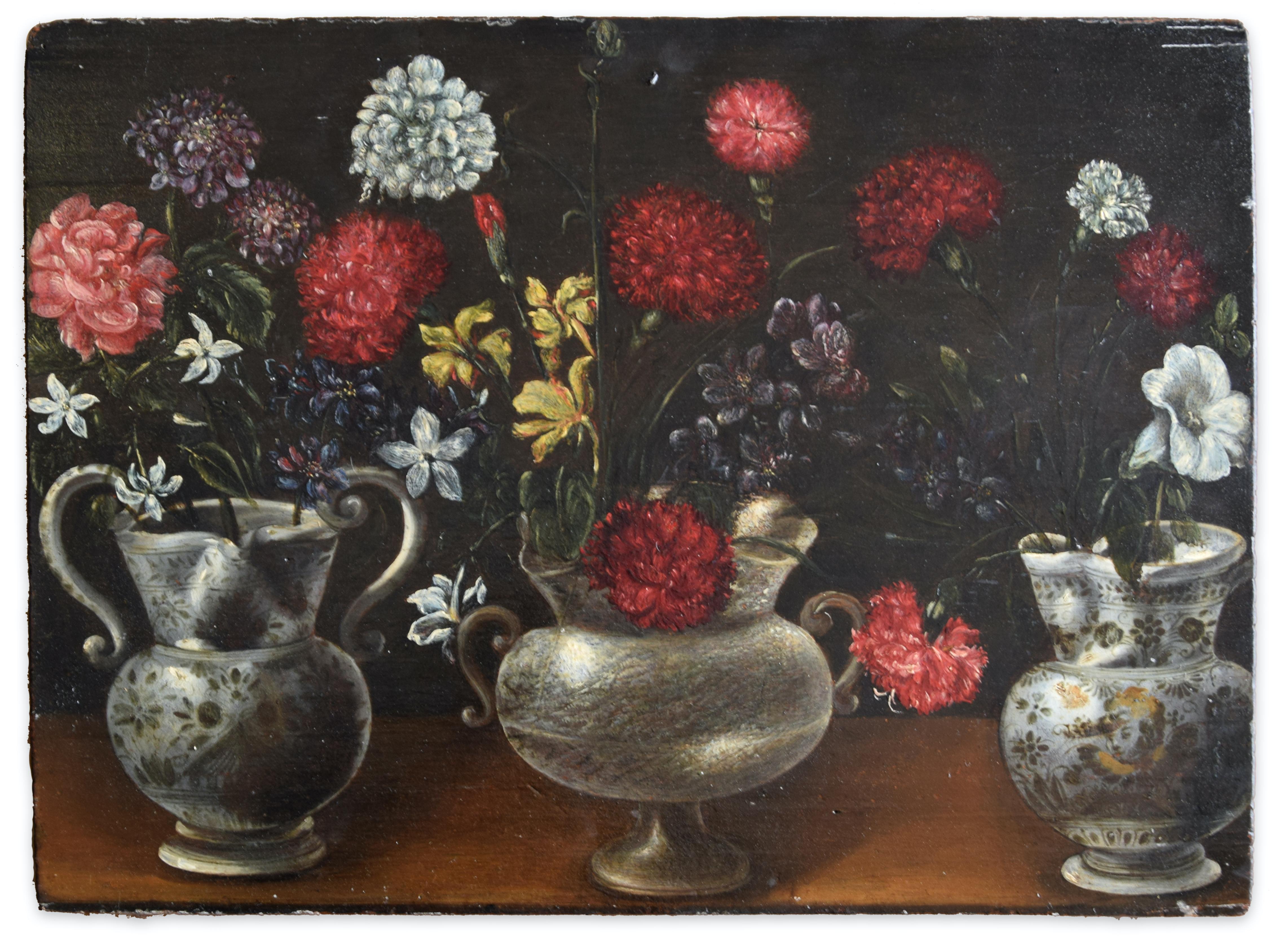Items Similar to Still Life, 17th Century Oil on Panel Painting
Want more images or videos?
Request additional images or videos from the seller
1 of 6
Harmen LoedingStill Life, 17th Century Oil on Panel Painting
About the Item
Oil on panel, monogrammed mid left
Image size: 15 x 12 1/4 inches (38 x 31 cm)
Dutch ripple style frame
Loeding was born in Leiden in around 1637 and was admitted into the Leiden Guild of St Luke in 1664. Like other Dutch cities, Leiden required membership in the guilds in order to sell wares falling under the various specifications. There is no record of his artistic training or influences, but he likely belonged to the circle of artists including Pieter de Ring and Gerrit Dou, who founded and maintained the Guild. Loeding is last registered as a member in 1673.
One of the most versatile genres that emerged from Dutch 17th Century artistic specialisms is that of 'pronkstilleven'; a laden table with a variety of rich textures, like ornate glassware, gilded goblets, exquisite nautilus cups, silver dishes, exclusive Chinese porcelains and costly fruits and other delicacies. Harmen Loeding was one of the virtuoso painters of these ensembles, who followed the famous 'pronk' still lifes of Jan Davidsz de Heem.
In this very beautiful still life Loeding presents a table partially covered with a brown cloth edged with silver fringes, upon which cascade translucent red cherries, apples, grapes and intertwined vines. In the centre stands a large glass of wine, known as a 'Roemer', which has the window of the room reflected on its edge. There is a spy glass seemingly discarded on the table. Powerful lighting is used to to create an atmosphere, entering from the left and casting a subtle play of light on the textures of the fruits.
Loeding has gone to great lengths to demonstrate his mastery in rendering a rich diversity of materials and textures, as well as his ability to capture reflected light in a variety of objects. He often used a vertical format and pyramidical structure of tightly packed objects in his still lifes, as is the case here. Fruits are some of the most ubiquitous subjects in still-life paintings over the centuries. Not only does a selection of fruit offer the artist a variety of colours and textures to utilise, they also offered a variety of symbols - grapes symbolising the themes of pleasure and lust associated with Bacchus, the Roman god of wine.
The inclusion of precious metals in still-life paintings certainly showcased an artist's skill at accurately depicting reflective textures. However, in this vanitas painting the golden plate, balancing precariously off of the table ledge, also evokes the tension that lies between materialism and morality. Glass was also pricey during this period, which made its symbolism all the more delicious to buyers: a half empty glass was a great stand-in for the brittle ephemerality of lived existence.
- Creator:Harmen Loeding (1637 - 1673, Dutch)
- Dimensions:Height: 15 in (38.1 cm)Width: 12.25 in (31.12 cm)
- More Editions & Sizes:1 of 1Price: $38,323
- Medium:
- Period:Mid-17th Century
- Condition:
- Gallery Location:London, GB
- Reference Number:1stDibs: LU52411804212
About the Seller
5.0
Vetted Seller
These experienced sellers undergo a comprehensive evaluation by our team of in-house experts.
Established in 2007
1stDibs seller since 2014
64 sales on 1stDibs
Typical response time: 2 hours
- ShippingRetrieving quote...Ships From: London, United Kingdom
- Return PolicyA return for this item may be initiated within 14 days of delivery.
More From This SellerView All
- Still Life of a Poppy, Iris and Peonies in a Glass VaseLocated in London, GBOil on canvas Image size: 23 1/4 x 19 1/2 inches (59 x 50 cm) Dutch Ripple frame PROVENANCE Private Collection, London Here a glass vase containing an exuberant display of flowers stands on a ledge. With only one known exception, Verelst included vases in all of his flower paintings. The asymmetrical arrangement of the flowers fills most of the canvas and the vibrant bouquet contains peonies, a bearded iris and a poppy set amidst a perfusion of twisting leaves and stems. Poppies were one of Verelst's favourite flowers and were commonly featured in his still life's. This painting shows a superb understanding of light and colour that is consistent with Verelst's other works. Indeed, the strong contrast between the brightly lit, the colourful blossoms and the surrounding darkness lends to the flowers and foliage a hyper realistic quality and a strong sense of three-dimensionality. The Artist Verelst was born in The Hague in 1644 and came from a family of painters. His brothers Johannes and Herman also became painters and, like Simon, were trained by their father. In 1663 Simon became a member of the Confrérie Pictura, the painter's association in The Hague, and soon afterwards moved to nearby Vooburg with his brother Herman, who also painted flowers. In 1668 Simon he moved to London where the Duke of Buckingham became his principle patron and on 11 April 1669 he met with Samuel Pepys. He was enormously successful in London and his elegant portraits became popular for a time during the 1670s among court circles. He painted this portrait of Prince Rupert, son of Frederick V, Count Palatine and Elizabeth Stuart...Category
Late 17th Century Naturalistic Still-life Paintings
MaterialsCanvas, Oil
- The Kitchen TableBy Caroline HutchinsonLocated in London, GBOil on canvas, signed on the reverse Image size: 19 1/2 x 23 1/4 inches (49.5 x 59 cm) Contemporary frame This still life provides an example of neo-impressionism, specifically of m...Category
Mid-20th Century Still-life Paintings
MaterialsOil, Canvas
- Study of Pink Lily and Peony, Contemporary Still LifeBy Jeremy AndrewsLocated in London, GBOil on canvas, signed and titled on reverse Image size: 12 x 16 inches (31 x 40 1/2 cm)Category
21st Century and Contemporary Still-life Paintings
MaterialsOil, Canvas
- Still Life with fruit and Delft plateLocated in London, GBOil on canvas Image size: 15 ½ x 19 ¼ inches (39.5 x 49 cm) 18th Century carved gilt frame Provenance Irish Country Estate This complex and convincing composition is painted from a...Category
17th Century Still-life Paintings
MaterialsOil, Canvas
- Summer Flowers 20th Century Modern BritishBy Gordon ScottLocated in London, GBGordon Scott ARCA 1914 - 2016 Summer Flowers Oil on canvas, signed lower left Image size: 23.5 x 20 inches Contemporary style frame Gordon Scott was trained at the Royal College of Art (1934-38) under Gilbert Spencer, Alan Sorrell and Charles Mahoney. In 1938 he was awarded a Travelling Scholarship by the R.C.A. for painting. A reserved and highly principled man, during WWII he was a conscientious objector, stationed at Bulford Camp on Salisbury Plain. His defined role there is unknown, but during his time there he produced a number of sketches and paintings of soldiers and other personnel who passed through the camp. In 1946 Joseph Dixon...Category
20th Century Modern Still-life Paintings
MaterialsOil, Canvas
- Camellias, 20th Century Oil Still LifeBy Christopher CashLocated in London, GBChristopher Cash 1890 -1980 Camellias Oil on board, signed lower right Image size: 19 1/2 x 15 1/2 inches Original frame Christopher Cash taught at Camberwell School of Art and live...Category
20th Century Still-life Paintings
MaterialsBoard, Oil
You May Also Like
- Illuminated Manuscript Painting by the German SchoolBy German SchoolLocated in New Orleans, LAExtraordinary in its beauty and rarity, this early 16th-century German painting of an illuminated manuscript showcases a masterful trompe l’oeil effect. Unequivocally among the finest of only 17 known works of its kind, the oil on panel is both rare and captivating. With illusory pages that appear to leap from the panel, this virtuosic painting of a hand-colored book suspended into space is exceptional. Created more than four centuries ago, the composition evokes a strong sense of realism. Executed by a masterful Northern Renaissance artist of the German school, the illuminated manuscript pictured shows the astonishing splendor of the historical books of the period. Sumptuously decorated with scrolling floral motifs in the margins, the manuscript appears before a deep black background, heightening the trompe l’oeil illusion of depth through its strong contrast and the naturalistic shadows falling across the fluttering pages. It has been said that of the 17 known versions of this composition, ours stands alone in its precision in both perspective and the play of light and shadow. The visible folios feature choral arrangements and other texts, indicating the pictured manuscript likely served a role in the celebration of church services. In fact, other examples of manuscript paintings...Category
16th Century Renaissance Still-life Paintings
MaterialsOil, Panel
- Still Life with Books and Pears - Oil Paint - Mid-20th CenturyLocated in Roma, ITStill life with books and pears is an artwork with frame, realized by an unknown artist of mid-20th Century. Oil on panel. 36 x 51 cm ; 56 x 70 cm with framed. Good conditionsCategory
Mid-20th Century Modern Figurative Paintings
MaterialsPanel, Oil
- Still Life with Bottles and Books - Oil Painting - Mid-20th CenturyLocated in Roma, ITStill Life with bottles and books is an artwork with frame, realized by an unknown artist of mid-20th Century. Oil on panel. 36 x 51 cm ; 56 x 70 cm with framed. Good condtionsCategory
Mid-20th Century Modern Figurative Paintings
MaterialsPanel, Oil
- "Last Rose Buds From My Garden, " Still Life Oil PaintingBy Yvonne MelchersLocated in Denver, COYvonne Melchers' "Last Rose Buds From My Garden" is an original, handmade oil painting that depicts two fully blossomed pink roses that compliment their green leaves in a glass vase with a plain white background. Artist Yvonne Melchers showcases her mastery of light and form in her sumptuously detailed paintings of subjects both intimate and universal. Whether painting a scene from her beloved North Sea Shore, the portrait of a strong but vulnerable young man dressed for the historical Siena Palio round, or the rumpled sheets and textures of a Venice hotel room, Melchers infuses each with a glow that speaks of the real and the ethereal. Precise technical skills join a rich historical palette and striking compositions in paintings that leave an indelible impression. (2019, Alessandro Tomassetti...Category
2010s Realist Still-life Paintings
MaterialsOil, Panel
- "Camellias From My Garden II, " Still Life Oil PaintingBy Yvonne MelchersLocated in Denver, COYvonne Melchers' "Camelias From My Garden II" is an original, handmade oil painting that depicts two fully blossomed pink camellias that compliment their green leaves in a glass pitcher with a plain white background. Artist Yvonne Melchers showcases her mastery of light and form in her sumptuously detailed paintings of subjects both intimate and universal. Whether painting a scene from her beloved North Sea Shore, the portrait of a strong but vulnerable young man dressed for the historical Siena Palio round, or the rumpled sheets and textures of a Venice hotel room, Melchers infuses each with a glow that speaks of the real and the ethereal. Precise technical skills join a rich historical palette and striking compositions in paintings that leave an indelible impression. (2019, Alessandro...Category
2010s Realist Still-life Paintings
MaterialsOil, Panel
- Still Life of Bouquet in two-handled vases - Oil on Panel by Vincenzo dé FioriLocated in Roma, ITStill Life is a superb original oil painting on panel, realized by the Italian artist Vincenzino Volò, best-known as Vincenzino dei Fiori (Rémondans, 1620-Milan, 1671) around 1640-1660. Original Title: Natura morta di fiori entro vasi biansati (Still life of Bouquet in two-handled vases). On the back of the panel, two labels are glued "da Milano", "A Piacenza", ("from Milan" "to Piacenza"). The labels indicate a transfer of the artwork, perhaps in the first half of the twentieth century, from Piacenza to Milan. While instead the style and technique make us understand the artwork was commissioned or created in the Milan of Federico Borromeo, archbishop of Milan from1595 to 1630. The author of the painting can be identified in the person of Vincenzo Volò, a talented artist who fell into oblivion, recently rediscovered and appreciated. Founder of the Vincenzini family, he was born in Franche-Comté in 1620 (in the past its birth was erroneously fixed to 1606). In the mid-forties of the seventeenth century he arrived to Milan, and held a leading artistic role: he was the founder of a family workshop that imposed his style and strongly influenced Milanese collecting with his still lifes and influenced generations and generations of painters. Vincenzino also was the first painter of still life to work on the Bella Island for Vitaliano VI Borromeo and collaborated with well-known figure painters such as Francesco Cairo, Scaramuccia, Nuvolone and Fumagalli. As regards the style, the archaic tendency of Lombard painting of still life from the early decades of the seventeenth century is clearly evident, looking at primitivism and the happy schematization of the composition of the artwork. The dating of this artwork could be fixed around the first half of the seventeenth century because it is confirmed by the type of support, a wooden panel, always used by Vincenzino. As for the subject, Volò generally painted bouquets of flowers in two-handled vases placed on transversal planes seen from the front. It is possible to compare this work with other Dei Fiori's artworks: the pair of Flower Vases...Category
Mid-17th Century Still-life Paintings
MaterialsWood Panel, Oil

